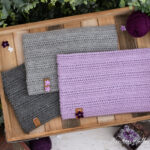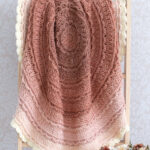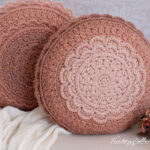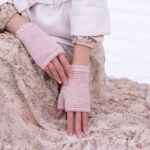These easy mittens are simple and stylish, while also being thick and warm. The crochet mitten pattern come in 3 sizes for women, kids, and toddlers. Find the free crochet pattern instructions below, or purchase a print-optimized, ad-free PDF by clicking here.
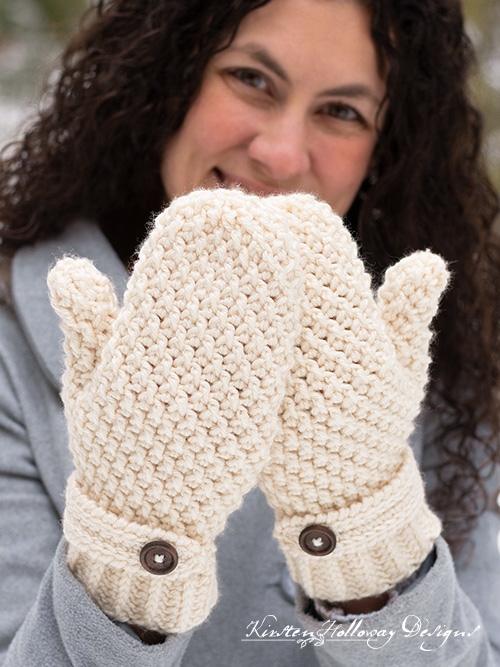
Mittens make a quick project that most people can crochet in an afternoon or evening. These mittens are worked top-down and use simple crochet stitches, but the details of the ribbed, knit-look wrist band and the wrist strap make this mitten pattern look more complex than in is.
Make it a set with the matching double seed stitch slouch hat pattern that also comes in 3 sizes.

The body of this mitten pattern uses single crochet and Front Post double crochet stitches. You will need to know how to crochet in the 3rd loop of a hdc stitch to complete the ribbed wrist band, and you will also need to know how to crochet the reverse single crochet or crab stitch, and how to do surface slip stitching. Out of all the finishing techniques you can do in crochet these are some of the easiest to master and give you the most professional results.

The most challenging portion of this mitten will most likely be the thumb. However, I’ve included some instructions to place stitch markers so that you will know where to work the stitches when you come to that part. Take the instructions one comma at a time and it will hopefully make more sense.
I’ve got a matching pair of fingerless mitts, and a pair of convertible mittens using this same stitch pattern coming soon! This way those of you who may not be stuck in the dead of winter in February (like I am) can still enjoy keeping your hands comfortable, but not over-heated.
Disclaimer: This post contains affiliate links. When you purchase something using these links a small amount of the sales price goes to me to help keep this site, and the patterns on it free. You do not pay any extra for the item you purchase.
Difficulty:
Easy/Intermediate
Techniques used: half-double crochet in the 3rd loop, reverse single crochet, surface slip stitching, front post double crochet, single crochet 2 together, and double crochet 2 together.
Materials Needed:
90, 175, 220 yards #4 worsted weight Red Heart Soft in the color of your choice.
3.75mm hook (band)
5mm hook, or hook needed to obtain gauge (body)
Yarn needle
Scissors
2 20mm buttons – child and adult sizes (optional)
4 3/8″ buttons – toddler size (optional)
Stitch Markers
Stitches used:
sl st = slip stitch
sc = single crochet
hdc = half double crochet
dc = double crochet
sc2tog = single crochet 2 together
dc2tog = double crochet 2 together
FPdc = front post double crochet
rsc = reverse single crochet (crab stitch)
Additional Terms:
hdc in the 3rd loop = Look at the top of the stitch, and locate the sideways “V”, bend the stitch to look at the back*, and you should see another “V”. You’ll be working into the back loop of that “V”, this is called the 3rd loop.
st/sts = stitch/stitches
prev = previous
Measurements:
Toddler (2-4 yrs) Mitten: 3 1/2” wide at widest point, by 6” long
Child (6-9 yrs) Mitten: 4″ wide at widest point, by 7″ long
Adult Mitten: 4 1/2” wide at widest point, by approximately 8-9 1/2” long (see additional notes) including wrist band, by 3 3/4”-4” across fingers.
Gauge: alternating FPdc in next st, sc in next st: 7 sts in 2” using 5mm hook. 12 rows of the same stitch gives 4” of height
Additional Notes:
-Ch 1 at beginning of round does not count as a stitch.
-This pattern can be made longer or shorter based on the length of the person’s hand that you are making the mittens for.
-Pull your joins snug to minimize the seam.
Easy Double Seed Stitch Mittens (US Terms):
Click here to purchase an ad-free, print-optimized PDF of this pattern on LoveCrafts
Toddler (2-4 yrs) Mittens Pattern (make 2):
Wrist Band:
This makes a short 1 1/8” wide wrist band. If you want to fold your wrist band over you can start by chaining 12 instead.
With 3.75mm hook,
Row 1: Leaving a 6″ tail, ch 6, hdc in 2nd ch from hook, hdc in each st across. (5)
Rows 2-18: ch 1, turn, working in 3rd loop of hdc from prev row, hdc in each st across. (5)
The band should measure about 6” long by approximately 1 1/4” wide and wrap comfortably around the child’s wrist.
Fold band in half and join row 18 to row 1 with a sl st.
Sew ends of band together with 6” tail.
Mitten body:
Using 5mm (H) hook, working along side of band,
Round 1: ch 1, sc in each st around, join with sl st to first sc (place stitch marker in sl st). (18)
Round 2: ch 1, sc in first st, FPdc around same st, sc in next st, *FPdc around next st, sc in next st; repeat from * around, dc in sl st where st marker is, join with sl st to first sc. (20)
Round 3: ch 1, FPdc around first st, *sc in next st, FPdc around next st; repeat from *around, join with sl st to first FPdc (place stitch marker in sl st). (20)
Round 4: ch 1, dc in top of first st, sc in same st, FPdc around next st, *sc in next st, FPdc around next st; repeat from * around, sc in sl st where stitch marker is, join with sl st to first dc. (22)
Round 5: ch 1, sc in first st, FPdc around next st, *sc in next st, FPdc around next st; repeat from * around, join with sl st to first sc (place stitch marker in sl st). (22)
Round 6: ch 1, sc in first st, FPdc around same st, sc in next st, *FPdc around next st, sc in next st; repeat from * around, dc in sl st where stitch marker is, join with sl st to first sc. (24)
Round 7: ch 1, FPdc around first st, sc in next st, *FPdc around next st, sc in next st; repeat from *around, join with sl st to first FPdc (place stitch marker in sl st). (24)
We will now make the thumb hole. Your thumb hole should take up 6 stitches. We’ll come back and add the thumb after we complete the body of the mitten. Slip stitches are not included in end of round counts for the following round.
Round 8: sl st over 3 sts, ch 1, [FPdc around sc, sc in next st] 9 times, sk 3 sts, join with sl st to first FPdc. (18)
Round 9: ch 1, sc in first st, FPdc around next st, *sc in next st, FPdc around next st; repeat from * around, join with sl st to first sc. (18)
Round 10: ch 1, FPdc around first st, sc in next st, *FPdc around next st, sc in next st; repeat from * around, join with sl st to first FPdc. (18)
Repeat rounds 9 and 10 until your mitten measures 5 1/2” long from top of band, then begin decreases. If you need a longer mitten for your child then repeat rounds 9 and 10 until the mitten is 1/2” from the bottom of the child’s longest finger, then begin decreases.
Decreases:
In the next round there are 2 different ways of doing the decreases: either you can work FPdc stitches around each sc and skip the FPdc stitches from the previous round, or you can work dc2tog stitches working one “leg” of the stitch as a normal dc and the other “leg” as a FPdc. They should be joined as dc2tog sts are normally at the top. The only difference is the positioning of each “leg”. Method 2 will give a denser fabric and is better for colder climates.
Round 1 (method 1): ch 1, FPdc around each sc st in the round, skipping all FPdc sts, join with sl st to first FPdc. (9)
Round 1 (method 2): ch 1, reduce opening by working dc2tog sts across the pairs of FPdc and sc sts. Each FPdc will get a dc “leg” worked in the top, and each sc will get a FPdc “leg” worked around it. (9)
Round 2: ch 1, *sc2tog; repeat from * around, sc in final st, join with sl st to first sc2tog. (5)
Fasten off leaving 6” tail for sewing end of mitten shut.
Mitten Thumb:
You will first work a sc2tog to close the gap that resulted from creating the thumb hole in round 8. The first part of the sc2tog will be worked in the sc and the dc where your stitch markers are. This sc2tog just serves to fill a gap and will be skipped in round 2 of the thumb.
Attach yarn to bottom of thumb hole closest to the mitten body,
Round 1: ch 1, sc2tog to close gap in round 8 of mitten body, FPdc around sc, *sc in next st, FPdc around next sc; repeat from * around, join with sl st to first sc2tog. (7)
Round 2: ch 1, sk sc2tog st, sc in next st, FPdc around next st, sc in next st; repeat from * around, join with sl st to first sc. (6)
Round 3: ch 1, FPdc around first st, sc in next st, *FPdc around next st, sc in next st; repeat from * around, join with sl st to first sc. (6)
Round 4: ch 1, sc in first st, FPdc around next st, *sc in next st, FPdc around next st; repeat from * around, join with sl st to first sc. (6)
Fasten off leaving 6” tail.
Sew end of thumb together with tail.
Wrist Strap:
With 3.75mm hook, leaving 6″ tail, ch 12,
Round 1: sc in 2nd ch from hook (place st marker in skipped ch) and in next 10 sts, 3 sc in final st of row, continue working sc down around other side in the next 10 sts, in ch-1 turning chain (with stitch marker) at end of row work 2 sc, join with sl st to first sc.
Using tight tension,
Round 2: ch 1, rsc in each st and ch-1 sp around.
Using relaxed tension, and continuing to work in the reverse direction,
Round 3: sl st in each st around between rounds 1 and 2.
Fasten off leaving a 6″ tail.
Center button strap on front of mitt or mitten just below wrist band. Sew to mitten with 6″ tails. You may sew a small ⅜” button onto each end of the strap.
Weave in all ends.
Child (6-9 yrs) Mittens Pattern (make 2):
Wrist Band:
This makes a short 1 1/4” wide wrist band. If you want to fold your wrist band over you can start by chaining 13 instead.
With 3.75mm hook,
Row 1: Leaving a 6″ tail, ch 7, hdc in 2nd ch from hook, hdc in each st across. (6)
Rows 2-20: ch 1, turn, working in 3rd loop of hdc from prev row, hdc in each st across. (6)The band should measure about 6 1/2” long by approximately 1 1/4” wide and wrap comfortably around the child’s wrist.
Fold band in half and join row 20 to row 1 with a sl st.
Sew ends of band together with 6” tail
Mitten body:
Using 5mm (H) hook, working along side of band,
Round 1: ch 1, sc in each st around, join with sl st to first sc (place stitch marker in sl st). (20)
Round 2: ch 1, sc in first st, FPdc around same st, sc in next st, *FPdc around next st, sc in next st; repeat from * around, dc in sl st where st marker is, join with sl st to first sc. (22)
Round 3: ch 1, FPdc around first st, sc in next st, *FPdc around next st, sc in next st; repeat from *around, join with sl st to first FPdc (place stitch marker in sl st). (22)
Round 4: ch 1, dc in top of first st, sc in same st, FPdc around next st, *sc in next st, FPdc around next st; repeat from * around, sc in sl st where stitch marker is, join with sl st to first dc. (24)
Round 5: ch 1, sc in first st, FPdc around next st, *sc in next st, FPdc around next st; repeat from * around, join with sl st to first sc (place stitch marker in sl st). (24)
Round 6: ch 1, sc in first st, FPdc around same st, sc in next st, *FPdc around next st, sc in next st; repeat from * around, dc in sl st where stitch marker is, join with sl st to first sc. (26)
Round 7: ch 1, FPdc around first st, sc in next st, *FPdc around next st, sc in next st; repeat from *around, join with sl st to first FPdc (place stitch marker in sl st). (26)
Round 8: ch 1, dc in top of first st, sc in same st, FPdc around next st, *sc in next st, FPdc around next st; repeat from * around, sc in sl st where stitch marker is, join with sl st to first dc. (28)
Round 9: ch 1, sc in first st, FPdc around next st, *sc in next st, FPdc around next st; repeat from * around, join with sl st to first sc (place stitch marker in sl st). (28)
Round 10: ch 1, sc in first st, FPdc around same st, sc in next st, *FPdc around next st, sc in next st; repeat from * around, dc in sl st where stitch marker is, join with sl st to first sc. (30)
We will now make the thumb hole. Your thumb hole should take up 8 stitches. We’ll come back and add the thumb after we complete the body of the mitten. Slip stitches are not included in end of round counts for the following round.
Round 11: sl st over 4 sts, ch 1, [FPdc around sc, sc in next st] 11 times, sk 4 sts, join with sl st to first FPdc. (22)
Round 12: ch 1, sc in first st, FPdc around next st, *sc in next st, FPdc around next st; repeat from * around, join with sl st to first sc. (22)
Round 13: ch 1, FPdc around first st, sc in next st, *FPdc around next st, sc in next st; repeat from * around, join with sl st to first FPdc. (22)
Repeat rounds 12 and 13 until the mitten is 1/2” from the bottom of their longest finger, then begin decreases.
Decreases:
In the next round there are 2 different ways of doing the decreases: either you can work FPdc stitches around each sc and skip the FPdc stitches from the previous round, or you can work dc2tog stitches working one “leg” of the stitch as a normal dc and the other “leg” as a FPdc. They should be joined as dc2tog sts are normally at the top. The only difference is the positioning of each “leg”. Method 2 will give a denser fabric and is better for colder climates.
Round 1 (method 1): ch 1, FPdc around each sc st in the round, skipping all FPdc sts, join with sl st to first FPdc. (11)
Round 1 (method 2): ch 1, reduce opening by working dc2tog sts across the pairs of FPdc and sc sts. Each FPdc will get a dc “leg” worked in the top, and each sc will get a FPdc “leg” worked around it. (11)
Round 2: ch 1, *sc2tog; repeat from * around, sc in final st, join with sl st to first sc2tog. (6)
Fasten off leaving 6” tail for sewing end of mitten shut.
Mitten Thumb:
You will first work a sc2tog to close the gap that resulted from creating the thumb hole in round 11. The first part of the sc2tog will be worked in the sc and the dc where your stitch markers are. This sc2tog just serves to fill a gap and will be skipped in round 2 of the thumb.
Attach yarn to bottom of thumb hole closest to the mitten body,
Round 1: ch 1, work sc2tog in top of sc and top of dc from round 13 to close gap from that round, FPdc around sc, *sc in next st, FPdc around next sc; repeat from * around, join with sl st to first sc2tog. (9)
Round 2: ch 1, sk sc2tog st, sc in next st, FPdc around next st, sc in next st; repeat from * around, join with sl st to first sc. (8)
Round 3: ch 1, FPdc around first st, sc in next st, *FPdc around next st, sc in next st; repeat from * around, join with sl st to first sc. (8)
Round 4: ch 1, sc in first st, FPdc around next st, *sc in next st, FPdc around next st; repeat from * around, join with sl st to first sc. (8)
Round 5: ch 1, FPdc around first st, sc in next st, *FPdc around next st, sc in next st; repeat from * around, join with sl st to first sc. (8)
Fasten off leaving a 6″ tail.
Sew end of thumb together with tail.
Wrist strap:
With 3.75mm hook, leaving 6″ tail, ch 14,
Round 1: sc in 2nd ch from hook (place st marker in skipped ch) and in next 12 sts, 3 sc in final st of row, continue working sc down around other side in the next 13 sts, in ch-1 turning chain (with stitch marker) at end of row (ch 1, 2 sc, ch 1), join with sl st to first sc.
Round 2: ch 1, rsc in each st and ch-1 sp around.
With 5mm hook, continuing to work in the reverse direction,
Round 3: sl st in each st around between rounds 1 and 2.
Fasten off leaving an 8″ tail.
Position end of button strap on top of wrist near seam. Sew to mitten with 8″ tail. Tack other end of button strap to opposite side of mitten with 6″ tail. Use this same tail to sew a 20mm button on about ½” to ¾” from the end of the strap. Remember your left and right mittens will have the straps on opposite sides of the mittens.
Adult Mittens Pattern (make 2):
Wrist band:
This makes a short 1 1/2” wrist band. If you want to fold your wrist band over you can start by chaining 15 instead.
With 3.75mm hook,
Row 1: Leaving a 6″ tail, ch 8, hdc in 2nd ch from hook, hdc in each st across. (7)
Rows 2-22 (24): ch 1, turn, working in 3rd loop of hdc from prev row, hdc in each st across. (7)
The smaller, 22 row wrist band should measure 7” long.
The larger, 24 row wrist band should measure 8” long.
Fold band in half and join row 22 (24) to row 1 with a sl st.
Sew ends of band together with 6” tail.
Mitten body:
Pick the round 1 Instructions based on which wrist band you made. You should end up with 24 sc after round 1 either way.
Using 5mm (H) hook, working along side of band,
Round 1 (smaller wrist band): ch 1, 2 sc in first st, sc in each st around, 2 sc in final st, join with sl st to first sc (place stitch marker in sl st). (24)
Round 1 (larger wrist band): ch 1, sc in each st around, join with sl st to first sc (place stitch marker in sl st). (24)
Round 2: ch 1, sc in first st, FPdc around same st, sc in next st, *FPdc around next st, sc in next st; repeat from * around, dc in sl st where st marker is, join with sl st to first sc. (26)
Round 3: ch 1, FPdc around first st, sc in next st, *FPdc around next st, sc in next st; repeat from *around, join with sl st to first FPdc (place stitch marker in sl st). (26)
Round 4: ch 1, dc in top of first st, sc in same st, FPdc around next st, *sc in next st, FPdc around next st; repeat from * around, sc in sl st where stitch marker is, join with sl st to first dc. (28)
Round 5: ch 1, sc in first st, FPdc around next st, *sc in next st, FPdc around next st; repeat from * around, join with sl st to first sc (place stitch marker in sl st). (28)
Round 6: ch 1, sc in first st, FPdc around same st, sc in next st, *FPdc around next st, sc in next st; repeat from * around, dc in sl st where stitch marker is, join with sl st to first sc. (30)
Round 7: ch 1, FPdc around first st, sc in next st, *FPdc around next st, sc in next st; repeat from *around, join with sl st to first FPdc (place stitch marker in sl st). (30)
Round 8: ch 1, dc in top of first st, sc in same st, FPdc around next st, *sc in next st, FPdc around next st; repeat from * around, sc in sl st where stitch marker is, join with sl st to first dc. (32)
Round 9: ch 1, sc in first st, FPdc around next st, *sc in next st, FPdc around next st; repeat from * around, join with sl st to first sc (place stitch marker in sl st). (32)
Round 10: ch 1, sc in first st, FPdc around same st, sc in next st, *FPdc around next st, sc in next st; repeat from * around, dc in sl st where stitch marker is, join with sl st to first sc. (34)
Round 11: ch 1, FPdc around first st, sc in next st, *FPdc around next st, sc in next st; repeat from *around, join with sl st to first FPdc (place stitch marker in sl st). (34)
Round 12: ch 1, dc in top of first st, sc in same st, FPdc around next st, *sc in next st, FPdc around next st; repeat from * around, sc in sl st where stitch marker is, join with sl st to first dc. (36)
We will now make the thumb hole. Your thumb hole should take up 10 stitches. We’ll come back and add the thumb after we complete the body of the mitten. Slip stitches are not included in end of round counts for the following round.
Round 13: sl st over 5 sts, ch 1, place stitch marker in sc (this will be from round 12), [FPdc around sc, sc in next st] 13 times, on final time place st marker in same st as last sc was worked (this will also be a FPdc from round 12), sk 5 sts, join with sl st to first FPdc. (26)
Round 14: ch 1, sc in first st, FPdc around next st, *sc in next st, FPdc around next st; repeat from * around, join with sl st to first sc. (26)
Round 15: ch 1, FPdc around first st, sc in next st, *FPdc around next st, sc in next st; repeat from * around, join with sl st to first FPdc. (26)
Repeat rounds 14 and 15 until the mitten is about 1/2” shorter than the tip of your fingers.
Decreases:
In the next round there are 2 different ways of doing the decreases: either you can work FPdc stitches around each sc and skip the FPdc stitches from the previous round, or you can work dc2tog stitches working one “leg” of the stitch as a normal dc and the other “leg” as a FPdc. They should be joined as dc2tog sts are normally at the top. The only difference is the positioning of each “leg”. Method 2 will give a denser fabric and is better for colder climates.
Round 1 (method 1): ch 1, FPdc around each sc st in the round, skipping all FPdc sts, join with sl st to first FPdc. (13)
Round 1 (method 2): ch 1, reduce opening by working dc2tog sts across the pairs of FPdc and sc sts. Each FPdc will get a dc “leg” worked in the top, and each sc will get a FPdc “leg” worked around it. (13)
Round 2: ch 1, *sc2tog; repeat from * around, sc in final st, join with sl st to first sc2tog. (7)
Fasten off leaving 6” tail for sewing end of mitten shut.
Mitten thumb:
You will first work a sc2tog to close the gap that resulted from creating the thumb hole in round 13. The first part of the sc2tog will be worked in the sc and the dc where your stitch markers are. This sc2tog just serves to fill a gap and will be skipped in round 2 of the thumb. Attach yarn to bottom of thumb hole closest to the mitten body,
Round 1: ch 1, work sc2tog in top of sc and top of dc from round 13 to close gap from that round, FPdc around sc, *sc in next st, FPdc around next sc; repeat from * around, join with sl st to first sc2tog. (11)
Round 2: ch 1, sk sc2tog st, *sc in next st, FPdc around next st; repeat from * around, join with sl st to first sc. (10)
Round 3: ch 1, FPdc in around first st, sc in next st, *FPdc around next st sc in next st; repeat from * around, join with sl st to first FPdc. (10)
Round 4: ch 1, sc in first st, FPdc around next st, *sc in next st, FPdc around next st; repeat from * around, join with sl st to first sc. (10)
Round 5: ch 1, FPdc in around first st, sc in next st, *FPdc around next st sc in next st; repeat from * around, join with sl st to first FPdc. (10)
Round 6: ch 1, sc in first st, FPdc around next st, *sc in next st, FPdc around next st; repeat from * around, join with sl st to first sc. (10)
Round 7: ch 1, FPdc around each sc st in the round, skipping all FPdc sts, join with sl st to first FPdc. (5)
Fasten off leaving a 6″ tail.
Sew end of thumb together with tail.
Wrist strap:
with 5mm hook, leaving 6″ tail, ch 19,
Round 1: sc in 2nd ch from hook (place st marker in skipped ch) and in next 16 sts, 3 sc in final st of row, continue working sc down around other side in the next 17 sts, in ch-1 turning chain (with stitch marker) at end of row (ch 1, 2 sc, ch 1), join with sl st to first sc.
With 3.75mm hook,
Round 2: ch 1, rsc in each st and ch-1 sp around.
With 5mm hook, continuing to work in the reverse direction,
Round 3: sl st in each st around between rounds 1 and 2.
Fasten off leaving a 8″ tail.
Position end of button strap on top of wrist near seam. Sew to mitten with 8″ tail. Tack other end of button strap to opposite side of mitten with 6″ tail. Use this same tail to sew a 20mm button on about ½” to ¾” from the end of the strap. Remember your left and right mittens will have the straps on opposite sides of the mittens.
Weave in all ends.
Want more gorgeous crochet patterns, and a little encouragement for your day? Sign up for my newsletter here! That way you’ll never miss out on special events, or freebies I’m offering.
JOIN ME ON SOCIAL MEDIA
I would love to see a picture when you’re done, so please feel free to come by my Facebook group and show off your finished project! Be sure to tag @kirstenhollowaydesigns when you share pictures of your project on Instagram!
You can also follow me on Facebook, Pinterest, Instagram, and Ravelry for more beautiful crochet patterns.
PATTERN TERMS AND CONDITIONS:
You are welcome to share the link to this pattern, using one image of your choice, on your site, but please do not share the written patterns themselves, this includes my Ravelry downloads or translations of these patterns, or use additional images. You do not have permission to use my images by themselves to create pinnable graphics for Pinterest, however they may be included in a roundup pin if there are 4 or more other patterns. If you sell finished items online, please do not use my pictures for your listings. I’m positive that your work is of high enough quality for you to sell the finished piece. Have confidence in your abilities! <3 Thank you!
This pattern was made to be used by individuals and small business crocheters alike. Selling your finished pieces in boutiques, at farmer’s markets, craft shows, and other local events is encouraged! Please credit/link Kirsten Holloway Designs when selling finished products online. The only thing I require is that this pattern not be used commercially to produce hundreds of thousands of copies. If you enjoyed this pattern or found it useful, why not share a link to this post with your friends?


